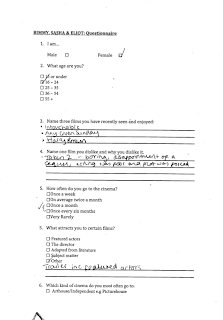7. Looking back at your preliminary task, what do you feel you have learnt in the progression from it to the final product?
The contrast between filming
the preliminary task to shooting our coursework opening has been vast. We faced
many differences between a short, 30-second piece and a much more demanding
2-minute opening, which required extensive refinement in comparison to the
roughness of the preliminary task, and I feel I have learnt a lot in the
process of overcoming these obstacles.
Firstly, the planning and
preparation was much more demanding for the opening task than what I needed for
the preliminary. I developed my skills in creating shot lists and storyboards,
giving the opening much more structure and development before shooting that the
preliminary ever had. Because of these planning techniques, when it came to
shooting I had a much clearer idea of the shots needed and angles required to
complete a certain sequence, and whilst editing I could refer to the storyboard
for guidance. For example whilst shooting the dream sequence of the opening I
filmed many shots we had not thought of in the planning stages, however during
editing I learnt how useful the storyboard was in helping me effectively use
these shots without loosing the narrative of the opening.
Logistically, I learnt a lot
in the difference of shooting on sight in the school for the preliminary to
filming on different locations around London. The group and I had to continuously
over think in our preparations for days of shooting, especially when preparing
the equipment, whereas for the preliminary all out equipment was on sight and
easily accessibly. These concerns combined with additional actors created some
tense moments during shooting, however we quickly learnt to thoroughly ensure
the equipment was correct and therefore filming became a lot smoother and
effective.
My use and knowledge of the
equipment also progressed in the time between the preliminary task and the
opening task. For the preliminary, I simply used one camera with no extras
equipment. However in the opening task, I used multiply lights, microphones and
a micro track simultaneously to achieve the desired effect. This required a
drastic increase in knowledge and capability with the equipment than I needed
for the preliminary; therefore I quickly progressed in order to utilize all
these benefits.
The area I progressed most in
was during the film editing. For the preliminary, my editing skills were
noticeably amateur and choppy, resulting in a jittery piece that did not run
smoothly and was extremely simple. In order to make the opening task seem more
professional and run generally smoother, I learnt a great deal about using
final cut pro and quickly developed my editing skills. This resulted in a much
smoother, sharper piece, with equalized sound, subtle effects and the
incorporation of graphics. My continuity editing also improved, with techniques
such as match on action, sound bridges and fades all being used to improve the
opening task.
Overall, I fell I have learnt
a lot in my progression from the preliminary to the opening task, in all
aspects of filming. I feel I have especially learnt the benefits of thorough preparation
in the planning stages, which I have seen have a great effecting in both the
shooting stage and finally the editing, leading to the smooth creation of the
opening task.



